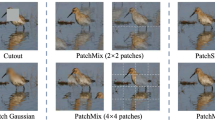Abstract
In this paper, a new augmentation algorithm based on the idea of blending two images is proposed. The method is developed using state-of-the-art generative diffusion neural networks and can be used to solve the problem of data scarcity, improve the training quality and robustness of neural networks. Flexible customization of the algorithm allows adding snow, rain and other weather conditions to the selected.






Similar content being viewed by others
REFERENCES
D. **ng and A. Tzes, “Synthetic aerial dataset for UAV detection via text-to-image diffusion models,” in Proceedings of IEEE Conference on Artificial Intelligence (CAI), Santa Clara, CA, USA, 2023. https://doi.org/10.1109/CAI54212.2023.00030
A. Nair and N. Mehendale, “Dronescape: A high-resolution drone footage dataset for tree region segmentation.” https://ssrn.com/abstract=4512595. Accessed July 17, 2023.https://doi.org/10.2139/ssrn.4512595
R. Rombach, A. Blattmann, D. Lorenz, P. Esser, and B. Ommer, “High-resolution image synthesis with latent diffusion models,” (2022). https://doi.org/10.48550/ar**v.2112.10752
A. Lugmayr, M. Danelljan, A. Romero, F. Yu, R. Timofte, and L. Van Gool, “Repaint: Inpainting using denoising diffusion probabilistic models,” (2022). ar**v:2201.09865.
L. Zhang and M. Agrawala, “Adding conditional control to text-to-image diffusion models,” (2023). ar**v: 2302.05543.
T. Brooks, A. Holynski, and A. A. Efros, “Instructpix2pix: Learning to follow image editing instructions,” (2022). ar**v:2211.09800.
A. Radford, J. W. Kim, C. Hallacy, A. Ramesh, G. Goh, S. Agarwal, G. Sastry, A. Askell, P. Mishkin, J. Clark, G. Krueger, and I. Sutskever, “Learning transferable visual models from natural language supervision,” (2021). ar**v:2103.00020.
A. Kirillov, E. Mintun, N. Ravi, H. Mao, C. Rolland, L. Gustafson, T. **ao, S. Whitehead, A. C. Berg, W.‑Y. Lo, et al., “Segment anything,” (2023). ar**v: 2304.02643.
J. Yu, Z. Wang, V. Vasudevan, L. Yeung, M. Seyedhosseini, and Y. Wu, “Coca: Contrastive captioners are image-text foundation models,” (2022). ar**v:2205.01917.
Funding
This work was supported by ongoing institutional funding. No additional grants to carry out or direct this particular research were obtained.
Author information
Authors and Affiliations
Corresponding author
Ethics declarations
The authors of this work declare that they have no conflicts of interest.
Additional information
Publisher’s Note.
Pleiades Publishing remains neutral with regard to jurisdictional claims in published maps and institutional affiliations.
Rights and permissions
About this article
Cite this article
Karachev, D., Shtekhin, S. & Stadnik, A. Using Hidden Feature Space of Diffusion Neural Networks for Image Blending Problem. Phys. Part. Nuclei 55, 347–350 (2024). https://doi.org/10.1134/S1063779624030468
Received:
Revised:
Accepted:
Published:
Issue Date:
DOI: https://doi.org/10.1134/S1063779624030468




